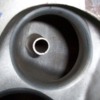These days I lean towards only profiling the portions of the valve pockets and combustions chambers into and out of the valve seats, and sizing the valve throats. Of course sharp edges, ridges, etc should be removed everywhere. For a Pantera the flat roof in the exhaust valve pockets and the bump in the exhaust port roof can be eliminated. Street engine throats should be 85% of the valve head OD max, or enough to get the sonic choke above red line as a minimum. You need room for a 0.060 wide intake seat, or a 0.080 wide exhaust seat, plus the 30 and 60 degree angles on either side of the seat. Roughly 0.3 inches less than the OD of the valve head, this applies to both intake and exhaust. Its very easy to open up the throat of the 2.19" intake pockets too far, and ruin the venturi. They are 1.75 off the shelf, and 1.90 is about the max you can take them. Caution must be used to not go too big.
I've always relied on others to perform the valve seat jobs, I've never owned valve seat grinding or cutting equip. But I always perform the valve guide work and pocket and combustion chamber blending work before I hand the head castings over to the seat grinder. Once the seats are ground that establishes the valve heights. I perform the spring seat work and rocker arm pedestal work (if any) afterwards.
Its common these days to completely remove the cast-in guides and press-in the exposed style of guides. The upper part of the guide, in the middle of the spring seat, can be knocked down with a fly cutter. The guide within the valve pocket will require a burr to knock it down. Sealed Power (Speed Pro) part no. VG-7501R is a universal guide that is almost exactly what is needed for the 351C, except its too long (assuming the valve stems are 0.3415 OD). It should be shortened to 1.625" insertion length (length below the flange). Once its pressed-in it should be sized with a 0.3430 reamer.
Match the head's port inlets to a gasket, just clean up the intake manifold runners if needed. They don't need to be matched, the head's port inlets should be bigger than the manifold runners, so there's no ridges in the air stream.
Monty, you mentioned doing the "essentials" but that left more questions in my mind than anything else. I mention all the above to clarify what "could be" essentials, and thus what tools, bits, sanding rolls, etc you'll need to get it done. Anything more than that is not an essential. Cleveland heads require less work than any other muscle car era head. Nothing major needs to be moved, nothing needs serious resizing, etc. All of the work excepting the seats I can do on my own, with a drill motor and some fly-cutters, a die grinder and sanding rolls, and a press and a reamer for the guides.
You asked about electric die grinders, Milwaukee, Bosch, or Makita, take your pick. The draw back of the electric die grinders is that they are heavier, and larger (more cumbersome) than their pneumatic counterparts. There are inexpensive sanding roll kits on eBay and at Summit Racing, check them out as a means to get started. The spring manufacturers, valve manufacturers, rocker arm manufacturers will have the cutting tools for their stuff. I always prefer Manley. McMaster Carr supplies a lot of the other stuff ... but there are other machine tool suppliers other than McMaster. McMaster is expensive but they ship FAST!
Getting ready to do a set of D3ZE heads myself.
Edited to add picture: The picture displays how the valve guide casting has been knocked-down and an exposed valve guide has been installed. It also reveals an excellent job of blending the pocket into the throat, the throat into the seats, and the seats into the combustion chamber. If you want to spend time on the head ... this is where to spend it, knocking down sharp edges, steps, and ridges and blending the various surfaces and contours. All while removing as little material as possible. The "pretty" work in the pocket and port are not as productive, but it sure is pretty. I have one suggestion, the valve could have been unshrouded better from about 11:00 to 1:00 in this picture (I make that comment a lot).
PANTERA INTERNATIONAL
A DE TOMASO CAR CLUB
Presents the De Tomaso Forums
The On-Line Meeting Place for De Tomaso Owners and Enthusiasts From Around the World
Clicking on the banner will take you to the sponsor's website.


